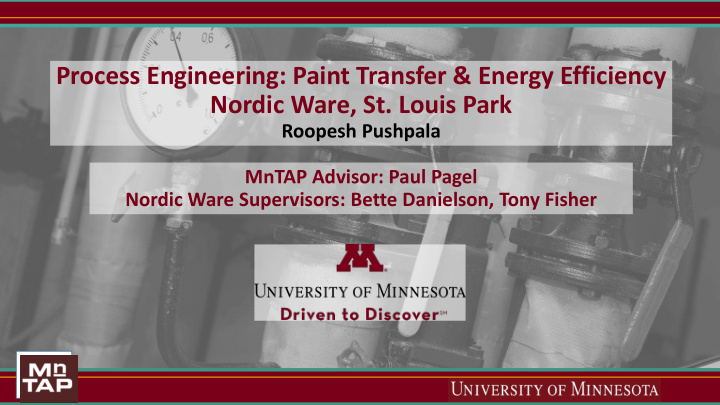



Process Engineering: Paint Transfer & Energy Efficiency Nordic Ware, St. Louis Park Roopesh Pushpala MnTAP Advisor: Paul Pagel Nordic Ware Supervisors: Bette Danielson, Tony Fisher
Company Background • Leading manufacturer of kitchenware products since 1946 • Cookware manufacturer • Metal fabrication • Coatings applications • Plastics molding • Wide range of products including castings, formed and molded products https://www.nordicware.com/
Project Overview • Opportunities to increase transfer efficiencies of the spray painting • Process improvement through the coating line • Optimize the washer processes • Conserve energy while increasing the production throughput
Coating Applications Analysis • Transfer efficiency in coating lines • Surface area, coating thickness, paint used • Process in coating applications • Working of compliant spray guns and delivery of the coating. • Belt speed, rotating speed and air pressure related to output. • Opportunity to improve • Chain on edge without spinning • Electrostatic spray guns • Overhead line
Findings • Transfer efficiency for grills: 42.3% • Transfer efficiency without rotation: 53% • New fixture for better coverage • Present line with infrared (IR) partial bake and existing oven • Overhead line with IR cure Recommendation Overhead line with electrostatic spray and IR cure • Load up to 6 parts on a fixture • Fewer touches and smaller system footprint
Recommendations – Potential Annual Savings Recommendation Paint VOC Labor Increase in Savings Investment Payback Status Reduction Reduction Reduction Production Period Overhead Line 3,300 6.80 tons 75% 200% $370,600 $475,000 1.3 years Recommended with IR Oven gallons IR Bake and 2,500 5.11 tons 37.5% - $189,000 $420,000 2.3 years Needs further Existing Oven gallons analysis Without Rotation 1,700 3.54 tons - - $56,900 - Immediate Needs further gallons analysis
Washer Analysis • Working process • Wash (1), rinse (2&3) and dryer, air knife • Belt speed, water consumption • Optimize the washing process • Foam in the rinse tank • High water use • Opportunity to improve • Eliminate foam • Efficient use of air knife • Upgrade spray nozzles
Findings Washer 1 & 2 Air Knife Rinse Pressure (psi) Water used (GPM) • Foam formation in stage 2 due to soft water Top Bottom D.I Soft City Initial 12 inches 15 15 11 16 - • Initial washer settings • 6 GPM with present nozzles Recommendations • Pressure of the nozzles in stage 2 & 3 • Air knife height adjustment - 4 inches • Conductivity of the deionized (DI) tank • City water usage in stage 2 • Low volume high pressure nozzles - 0.3 GPM • Standard work procedure
Recommendations – Potential Annual Savings Washer Air Rinse Pressure Water used (GPM) 1 & 2 Knife (psi) Top Bottom DI Soft City Present 4 10 8 4 - 3 Optimize Washer Reduction Savings Status Water & Sewer 9,093,000 $57,400 Implemented (Based on 2015) gallons Softener Salt 28.5 tons $7,800 Implemented DI Recharge 9 tanks $21,200 Implemented Total $86,400
Summary – Potential Annual Savings Recommendation Reduction Savings Status 3,300 gallons of paint Implement Overhead 6.80 tons of VOC $370,600 Recommended Line with IR Oven 75% Labor 9,093,000 gallons of water Optimize Washer 28.5 tons of salt $86,400 Implemented Operation 9 DI tanks Standard Work Defects in working process - In Process Total Savings $457,000 -
Next Steps • Planning and implementation of the new coating line • Standard work procedure for coating processes • Automation of the washer process • Evaluating the throughput based on the standard work for the washer
Personal Benefits • Industrial experience • Professional exposure • Manufacturing principles • New contacts in the industry • Ability to approach a problem
Thank you … This project was sponsored in part by CCAI
Recommend
More recommend